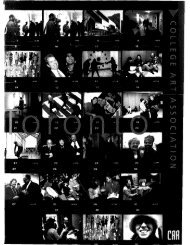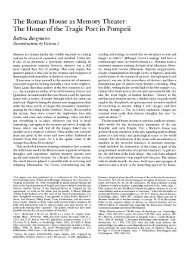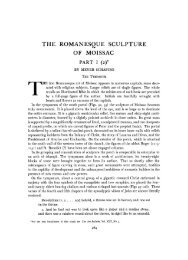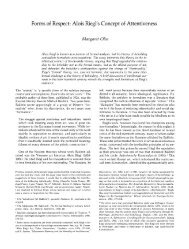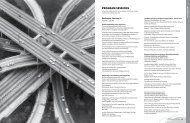THE HUMANISTIC THEORY OF PAINTING - College Art Association
THE HUMANISTIC THEORY OF PAINTING - College Art Association
THE HUMANISTIC THEORY OF PAINTING - College Art Association
You also want an ePaper? Increase the reach of your titles
YUMPU automatically turns print PDFs into web optimized ePapers that Google loves.
UT PICTURA POESIS: <strong>HUMANISTIC</strong> <strong>THE</strong>ORY <strong>OF</strong> <strong>PAINTING</strong> 219<br />
critical writing of the sixteenth century. Thus when Armenini, remembering Plutarch,<br />
tells how Cassender trembled before the life-like portrait of the dead Alexander whom he<br />
had learned to fear, he illustrates with the authority of antique example the concept that<br />
painting as an art expressive of human emotion has power to move the beholder.9" Horace,<br />
we have seen, was the foremost authority for this concept, but it should also be remarked<br />
that writers on expressive movement in painting, no less than critics of literature who<br />
were discussing the power of language to interpret and arouse the passions, also owed much<br />
to Cicero and Quintilian. For in shaping the education of the ideal orator, the ancient<br />
rhetoricians had been concerned not merely with words, but equally with gesture and facial<br />
expression as vital means of conveying human emotion. The Renaissance critics had, in<br />
fact, their invitation to compare painting with oratory in Quintilian's own observation that<br />
it is no wonder that gesture in oratory has a powerful effect on the mind, when the silent<br />
gestures in a painting can so penetrate to the heart that they seem to surpass in efficacy<br />
the power of speech itself.97<br />
Alberti had counseled the painter to read the "rhetorici,"98 and Leonardo may possibly<br />
remember Quintilian when he advises the painter to learn the fine points of expressive<br />
movement from the dumb whose only speech is gesture;99 but virtually always, as one<br />
would expect, Leonardo based his remarks on expression not on written prescription, but<br />
on his own keen observation of human life. Thus when he compares the movements of arm<br />
and hand that accompany the words of the orator intent on persuading his audience with<br />
those movements which must, if the painter's illusion of life is to be convincing (all the<br />
more, in fact, because painting is mere illusion, not reality), unfailingly express the mental<br />
activity of the persons represented,t00 he is evidently not thinking of the counsel of a<br />
Quintilian, but remembering his own experience of advocates in the courts, including those<br />
stupid advocates who, as they sought to persuade without the proper use of gestures,<br />
resembled wooden statues-a warning to painters not to neglect the study of movement<br />
without which their own figures might seem equally wooden. Leonardo's conviction that<br />
painting which does not convincingly externalize the passions of the soulPo"-admiration,<br />
reverence, grief, suspicion, fear, joy, and the like-is, in his habitual phrase, "twice dead,"'02<br />
96. Life of Alexander, Lxxiv; Armenini, De' veri precetti<br />
della pittura, I, 3, P. 30; cf. Alberti, Della pittura, p. 89.<br />
97. Inst. orat. xI. 3, 67: "Nec mirum, si ista, quae tamen<br />
in aliquo posita sunt motu, tantum in animis valent, cum<br />
pictura, tacens opus et habitus semper eiusdem, sic in<br />
intimos penetret adfectus, ut ipsam vim dicendi nonnun-<br />
quam superare videatur"; cf. xI. 3, 65 ff., and Cicero De<br />
oratore III. 59, a chapter on the significance of gesture<br />
and facial expression as indicative of the motus animi that<br />
follows one containing illustrations of these emotions from<br />
the poets. Cf. also Alberti, pp. 121-31; Dolce, pp. io8, 206;<br />
du Fresnoy, De arte graphica, 230 ff., and note how the<br />
latter declares it is the rhetorician's business to treat of the<br />
passions: "Hos ego Rhetoribus tractandos defero"; cf. note<br />
66 for some relevant remarks of Poussin.<br />
For the influence of the ancient theory of rhetoric on the<br />
Renaissance theory of poetry which, in regard to matters<br />
of expression, parallels its influence on the theory of paint-<br />
ing, see Murray W. Bundy's introduction to Kelso's trans-<br />
lation of Fracastoro's Naugerius (see note 31). The Nauge-<br />
rius is full of comparisons between the poet and the orator.<br />
Vida (De arte poetica, II. 496 ff.) advises the poet who seeks<br />
by the expression of human emotion to move his hearers to<br />
consult the eloquence of the great orators:<br />
"Nec te oratores pigeat, artisque magistros<br />
Consuluisse, Sinon Phrygios quo fallere possit<br />
<strong>Art</strong>e, dolis quocunque animos impellere doctus;<br />
Discitur hinc etenim sensus mentesque legentum<br />
Flectere, diversosque animis motus dare, ut illis<br />
Imperet arte potens, dictu mirabile, vates.<br />
Nam semper, seu laeta canat, seu tristia moerens,<br />
Affectas implet tacita dulcedine mentes."<br />
98. Op. cit., pp. 145-47.<br />
99. Trattato, III, 376.<br />
100. Ibid., 368.<br />
o10. Leonardo succinctly states the dramatic theory of<br />
expression that was to become standard in all essentials<br />
throughout Renaissance and Baroque criticism of painting<br />
in the following passage (ibid., 285): "et ancora ti ricordo<br />
... et sopra tuto, che li circonstanti al caso, per il quale &<br />
fatta la storia, sieno intenti a esso caso, con atti che mostrino<br />
admiratione, riverentia, dolore, sospetto, paura, gaudio, o'<br />
secondo che richiede il caso, per il quale e fatto il congionto<br />
o' uero concorso delle tue figure." Expression of the pas-<br />
sions must, then, in each case be strictly related to the<br />
dramatic motive in the picture. This was to be the doctrine<br />
of the French Academy.<br />
102. Ibid., 297, 368, etc.



